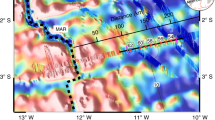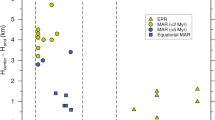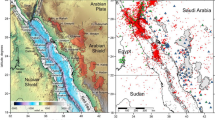Abstract
Along ultraslow-spreading ridges, where oceanic tectonic plates drift very slowly apart, conductive cooling is thought to limit mantle melting1 and melt production has been inferred to be highly discontinuous2,3,4. Along such spreading centres, long ridge sections without any igneous crust alternate with magmatic sections that host massive volcanoes capable of strong earthquakes5. Hence melt supply, lithospheric composition and tectonic structure seem to vary considerably along the axis of the slowest-spreading ridges6. However, owing to the lack of seismic data, the lithospheric structure of ultraslow ridges is poorly constrained. Here we describe the structure and accretion modes of two end-member types of oceanic lithosphere using a detailed seismicity survey along 390 kilometres of ultraslow-spreading ridge axis. We observe that amagmatic sections lack shallow seismicity in the upper 15 kilometres of the lithosphere, but unusually contain earthquakes down to depths of 35 kilometres. This observation implies a cold, thick lithosphere, with an upper aseismic zone that probably reflects substantial serpentinization. We find that regions of magmatic lithosphere thin dramatically under volcanic centres, and infer that the resulting topography of the lithosphere–asthenosphere boundary could allow along-axis melt flow, explaining the uneven crustal production at ultraslow-spreading ridges. The seismicity data indicate that alteration in ocean lithosphere may reach far deeper than previously thought, with important implications towards seafloor deformation and fluid circulation.
This is a preview of subscription content, access via your institution
Access options
Subscribe to this journal
Receive 51 print issues and online access
$199.00 per year
only $3.90 per issue
Buy this article
- Purchase on Springer Link
- Instant access to full article PDF
Prices may be subject to local taxes which are calculated during checkout



Similar content being viewed by others
References
Bown, J. W. & White, R. S. Variation with spreading rate of oceanic crustal thickness and geochemistry. Earth Planet. Sci. Lett. 121, 435–449 (1994)
Dick, H., Lin, J. & Schouten, H. An ultraslow-spreading class of ocean ridge. Nature 426, 405–412 (2003)
Sauter, D. & Cannat, M. The ultraslow spreading Southwest Indian Ridge. Geophys. Monogr. Ser. 188, 153–173 (2010)
Michael, P. J. et al. Magmatic and amagmatic seafloor generation at the ultraslow-spreading Gakkel ridge, Arctic Ocean. Nature 423, 956–961 (2003)
Schlindwein, V. Teleseismic earthquake swarms at ultraslow spreading ridges: indicator for dyke intrusions? Geophys. J. Int. 190, 442–456 (2012)
Cannat, M. et al. Modes of seafloor generation at a melt-poor ultraslow-spreading ridge. Geology 34, 605–608 (2006)
White, R. S., McKenzie, D. & O’Nions, R. K. Oceanic crustal thickness from seismic measurements and rare earth element inversions. J. Geophys. Res. 97, 19683–19715 (1992)
Anderson, D. L. Lithosphere, asthenosphere, and perisphere. Rev. Geophys. 33, 125–149 (1995)
Cannat, M. How thick is the magmatic crust at slow spreading oceanic ridges? J. Geophys. Res. 101, 2847–2857 (1996)
Edmonds, H. N. et al. Discovery of abundant hydrothermal venting on the ultraslow-spreading Gakkel Ridge in the Arctic Ocean. Nature 421, 252–256 (2003)
Cannat, M. Emplacement of mantle rocks in the seafloor at mid-ocean ridges. J. Geophys. Res. 98, 4163–4172 (1993)
Niu, X. et al. Along-axis variation in crustal thickness at the ultraslow spreading Southwest Indian Ridge (50°E) from a wide-angle seismic experiment. Geochem. Geophys. Geosyst. 16, 468–485 (2015)
Escartin, J. et al. Central role of detachment faults in accretion of slow-spreading oceanic lithosphere. Nature 455, 790–794 (2008)
Schlindwein, V., Demuth, A., Geissler, W. H. & Jokat, W. Seismic gap beneath Logachev Seamount: indicator for melt focusing at an ultraslow mid-ocean ridge? Geophys. Res. Lett. 40, 1703–1707 (2013)
Schlindwein, V. The expedition of the research vessel “Polarstern” to the Antarctic in 2013 (ANT-XXIX/8). Rep. Polar Marine Res . 672, 14–22 (2014)
Dusunur, D. et al. Seismological constraints on the thermal structure along the Lucky Strike segment (Mid-Atlantic Ridge) and interaction of tectonic and magmatic processes around the magma chamber. Mar. Geophys. Res. 30, 105–120 (2009)
Cannat, M., Rommevaux-Jestin, C. & Fujimoto, H. Melt supply variations to a magma-poor ultra-slow spreading ridge (Southwest Indian Ridge 61° to 69°E). Geochem. Geophys. Geosyst. 4, 9104 (2003)
Montési, L. G. J., Behn, M. D., Hebert, L. B., Lin, J. & Barry, J. L. Controls on melt migration and extraction at the ultraslow Southwest Indian Ridge 10°–16°E. J. Geophys. Res . 116, B10102 (2011)
Standish, J. J., Dick, H. J. B., Michael, P. J., Melson, W. G. & O’Hearn, T. MORB generation beneath the ultraslow spreading Southwest Indian Ridge (9–25°E): major element chemistry and the importance of process versus source. Geochem. Geophys. Geosyst. 9, Q05004 (2008)
Cannat, M., Rommevaux-Jestin, C., Sauter, D., Deplus, C. & Mendel, V. Formation of the axial relief at the very slow spreading Southwest Indian Ridge (49° to 69°E). J. Geophys. Res. 104, 22825–22843 (1999)
Amiguet, E. et al. Creep of phyllosilicates at the onset of plate tectonics. Earth Planet. Sci. Lett. 345–348, 142–150 (2012)
Schwartz, S. et al. Pressure–temperature estimates of the lizardite/antigorite transition in high pressure serpentinites. Lithos 178, 197–210 (2013)
Escartín, J., Hirth, G. & Evans, B. Strength of slightly serpentinized peridotites: implications for the tectonics of oceanic lithosphere. Geology 29, 1023–1026 (2001)
Rouméjon, S. & Cannat, M. Serpentinization of mantle-derived peridotites at mid-ocean ridges: mesh texture development in the context of tectonic exhumation. Geochem. Geophys. Geosyst. 15, 2354–2379 (2014)
Sauter, D., Cannat, M. & Mendel, V. Magnetization of 0–26.5 Ma seafloor at the ultraslow spreading Southwest Indian Ridge, 61°–67°E. Geochem. Geophys. Geosyst. 9, Q04023 (2008)
Sleep, N. H. & Warren, J. M. Effect of latent heat of freezing on crustal generation at low spreading rates. Geochem. Geophys. Geosyst. 15, 3161–3174 (2014)
Cannat, M. et al. Spreading rate, spreading obliquity, and melt supply at the ultraslow spreading Southwest Indian Ridge. Geochem. Geophys. Geosyst. 9, Q04002 (2008)
Simão, N. et al. Regional seismicity of the Mid-Atlantic Ridge: observations from autonomous hydrophone arrays. Geophys. J. Int. 183, 1559–1578 (2010)
deMartin, B. J., Sohn, R. A., Pablo Canales, J. & Humphris, S. E. Kinematics and geometry of active detachment faulting beneath the Trans-Atlantic Geotraverse (TAG) hydrothermal field on the Mid-Atlantic Ridge. Geology 35, 711–714 (2007)
Sauter, D. et al. Continuous exhumation of mantle-derived rocks at the Southwest Indian Ridge for 11 million years. Nat. Geosci. 6, 314–320 (2013)
Maus, S. et al. EMAG2: a 2-arc min resolution Earth Magnetic Anomaly Grid compiled from satellite, airborne, and marine magnetic measurements. Geochem. Geophys. Geosyst. 10, Q08005 (2009)
Schweitzer, J. HYPOSAT—an enhanced routine to locate seismic events. Pure Appl. Geophys. 158, 277–289 (2001)
Kissling, E., Ellsworth, W. L., Eberhart-Phillips, D. & Kradolfer, U. Initial reference models in local earthquake tomography. J. Geophys. Res. 99, 19635–19646 (1994)
Jokat, W., Kollofrath, J., Geissler, W. H. & Jensen, L. Crustal thickness and earthquake distribution south of the Logachev Seamount, Knipovich Ridge. Geophys. Res. Lett. 39, L08302 (2012)
Minshull, T. A., Muller, M. R. & White, R. S. Crustal structure of the Southwest Indian Ridge at 66°E: seismic constraints. Geophys. J. Int. 166, 135–147 (2006)
McKenzie, D., Jackson, J. & Priestley, K. Thermal structure of oceanic and continental lithosphere. Earth Planet. Sci. Lett. 233, 337–349 (2005)
Chen, W.-P. & Molnar, P. Focal depths of intracontinental and intraplate earthquakes and their implications for the thermal and mechanical properties of the lithosphere. J. Geophys. Res. 88, 4183–4214 (1983)
Chen, W.-P. & Molnar, P. A nonlinear rheology model for mid-ocean ridge axis topography. J. Geophys. Res. 95, 17583–17604 (1990)
Montési, L. G. J. & Behn, M. D. Mantle flow and melting underneath oblique and ultraslow mid-ocean ridges. Geophys. Res. Lett. 34, L24307 (2007)
Acknowledgements
This study was enabled by grants SCHL853/1-1 and SCHL853/3-1 of the German Science Foundation to V.S. Instruments were borrowed from the DEPAS pool. We acknowledge the efforts of the crews of RV Polarstern cruises ANT-XXIX/2+8 and ARK-XXIV/3, RV Meteor cruise M101 and RV Marion Dufresne.
Author information
Authors and Affiliations
Contributions
V.S. planned and conducted the surveys, processed data for site 3 and wrote the paper. F.S. processed data from site 1. Both authors discussed the results and commented on the manuscript.
Corresponding author
Ethics declarations
Competing interests
The authors declare no competing financial interests.
Additional information
Reviewer Information Nature thanks S. M. Carbotte and the other anonymous reviewer(s) for their contribution to the peer review of this work.
Extended data figures and tables
Extended Data Figure 1 Earthquake location at survey site 1 including poorly located events.
a, Epicentres (circles) colour-coded by hypocentre depth. Earthquakes not projected onto the cross-section (white line) in c are shown by squares. The red inverted triangles show OBS locations and the dashed blue line shows the position of the refraction seismic line15 used to constrain velocities in the uppermost lithosphere. b, The final velocity model used for earthquake location is shown in red, and the velocity models used for the robustness tests are shown in blue (the fast end-member representing a thin crust with ultramafic rocks underneath) orange (a velocity reduction of 0.3 km s−1 relative to the final model) and purple (a velocity increase of 0.3 km s−1 relative to the final model). Velocities of 7.0–7.6 km s−1 (grey bar) are considered anomalously low for lithospheric mantle. The histograms show the distribution of hypocentre depths obtained for the different velocity models. Faster models result in fewer well-located events, but the depth distribution is similar (see Extended Data Table 2). c, Cross-section of the hypocentres projected onto the axis and colour-coded according to the distance from the profile. The topography of the seismicity band is not an artefact of projection because at all depth intervals the earthquakes from various off-axis distances are present. The aseismic regions remain devoid of seismicity even when all poorly located earthquakes are shown.
Extended Data Figure 2 Earthquake location at survey site 2 including poorly located events.
a, Epicentres (circles) colour-coded by hypocentre depth. Earthquakes not projected onto the cross-section (white line) in c are shown by the squares. The red inverted triangles show OBS locations and the dashed blue line indicates the position of the refraction seismic line34 used to constrain velocities in the uppermost lithosphere. b, The final velocity model used for the earthquake location is shown in red and the velocity models used for the robustness tests are shown in blue (the fast end-member representing a thin crust with ultramafic rocks underneath) orange (a velocity reduction of 0.3 km s−1 relative to the final model) and purple (a velocity increase of 0.3 km s−1 relative to the final model). Velocities of 7.0–7.6 km s−1 (grey bar) are considered as anomalously low for lithospheric mantle. The histograms show the distribution of hypocentre depths obtained for the different velocity models. Faster models result in fewer well located events, but the depth distribution is similar (see Extended Data Table 2). c, Cross-section of the hypocentres projected onto the axis and colour-coded according to the distance from the profile. The topography of the seismicity band is not an artefact of projection because for all depth intervals the earthquakes from various off-axis distances are present. The aseismic regions remain devoid of seismicity even when all poorly located earthquakes are shown.
Extended Data Figure 3 Earthquake location at survey site 3 including poorly located events.
a, Epicentres (circles) colour-coded by hypocentre depth. Earthquakes not projected onto the cross-section (white line) in c are shown by the squares. The red inverted triangles show OBS locations and the dashed blue line indicates the position of the refraction seismic lines35 used to constrain velocities in the uppermost lithosphere. b, The final velocity model used for the earthquake location is shown in red and the velocity models used for the robustness tests are shown in blue (the fast end-member representing a thin crust with ultramafic rocks underneath) orange (a velocity reduction of 0.3 km s−1 relative to the final model) and purple (a velocity increase of 0.3 km s−1 relative to the final model). Velocities of 7.0–7.6 km s−1 (grey bar) are considered as anomalously low for lithospheric mantle. The histograms show the distribution of hypocentre depths obtained for the different velocity models. Faster models result in fewer well-located events, but the depth distribution is similar (see Extended Data Table 2). c, Cross-section of the hypocentres projected onto the axis and colour-coded according to the distance from the profile. The topography of the seismicity band is not an artefact of projection because at all depth intervals the earthquakes from various off-axis distances are present. The aseismic regions remain devoid of seismicity even when all poorly located earthquakes are shown.
Extended Data Figure 4 Contrasting magmatic and amagmatic sections of western SWIR.
a, Teleseismic earthquake activity (open circles, scaled with magnitude) over bathymetry. The light yellow circles mark earthquake clusters of two or more events that are related in time and space. Data from ref. 5. b, Dredge lithology. Data from ref. 2. c, Magnetic anomalies. Data from ref. 31. Earthquakes from a are shown by the dots. The predominantly magmatic orthogonal supersegment shows more abundant and often clustered teleseismic earthquakes and a marked magnetic anomaly. The predominantly amagmatic oblique supersegment shows less seismicity and peridotite exposure. Areas of magmatic and amagmatic lithosphere within this segment are defined from the seafloor lithology and magnetic patterns. The differences in the event rates within segments (see Fig. 2) are not visible here owing to a large uncertainty in earthquake locations.
Rights and permissions
About this article
Cite this article
Schlindwein, V., Schmid, F. Mid-ocean-ridge seismicity reveals extreme types of ocean lithosphere. Nature 535, 276–279 (2016). https://doi.org/10.1038/nature18277
Received:
Accepted:
Published:
Issue Date:
DOI: https://doi.org/10.1038/nature18277
This article is cited by
-
Oceanic mantle beneath ultraslow spreading ridges metasomatized by variably evolved melts
Contributions to Mineralogy and Petrology (2024)
-
Microseismicity and lithosphere thickness at a nearly-amagmatic oceanic detachment fault system
Nature Communications (2023)
-
Sulfide metallogenic model for the ultraslow-spreading Southwest Indian Ridge
Science China Earth Sciences (2023)
-
Giant sponge grounds of Central Arctic seamounts are associated with extinct seep life
Nature Communications (2022)
-
Effective Elastic Thickness of the Lithosphere in the Mariana Subduction Zone and Surrounding Regions and Its Implications for Their Tectonics
Journal of Ocean University of China (2022)
Comments
By submitting a comment you agree to abide by our Terms and Community Guidelines. If you find something abusive or that does not comply with our terms or guidelines please flag it as inappropriate.



